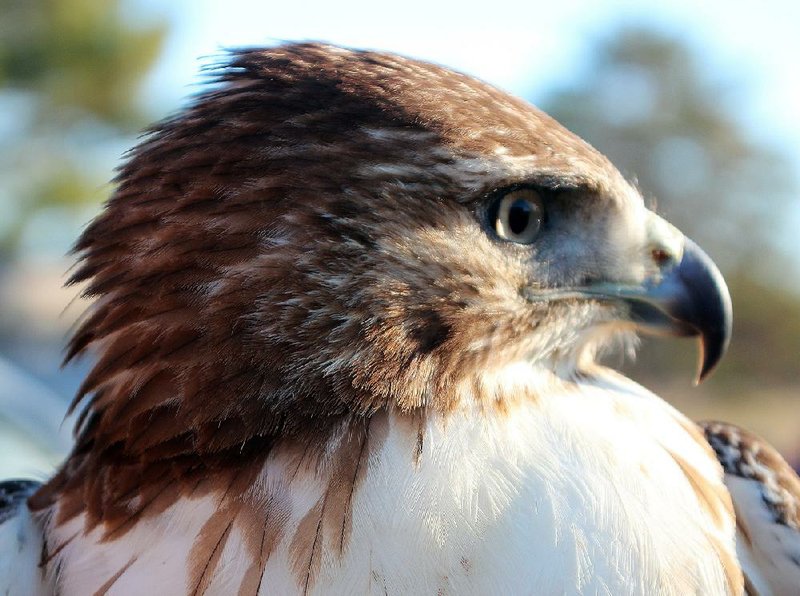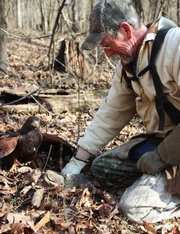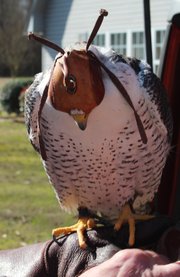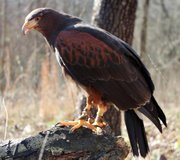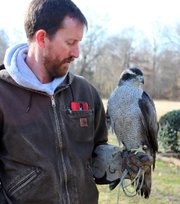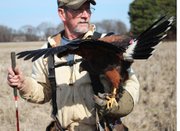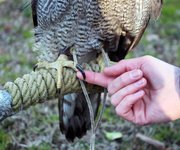The little gray squirrel is a fighter. He has been shaken from his nest way up in a tree, chased high-speed across thin, bare limbs that stretched toward a gorgeous blue February sky, knocked to the ground, rooted from a hidey-hole in the forest floor and finally pinned among dead leaves by the talons of his pursuer, a year-old female Harris's hawk named Kuwa.
She is not alone. Kuwa is hunting with Nata, another Harris's hawk, and their owners Ron and Brenda Russell, raptor breeders from Delight. It's a clear, chilly Saturday in early February, and the birds and their owners are part of the annual field meet of the Arkansas Hawking Association at Butler Lodge. They're on the edge of the White River National Wildlife Refuge in the Arkansas County farming community of Ethel.
The meet brings together falconers and their birds from across the state, as well as from Louisiana and Oklahoma, to hunt squirrels, rabbits and ducks and bond over a sport that is believed to have begun in Mesopotamia about 2000 B.C.
WILD LIFE
"Falconry is a hunting sport," says former hawking association president and current Eastern Director Heath Garner, 46, of Jonesboro. "There's an art form to it, too, and it's the relationship you have with a wild animal."
The emphasis here is on "wild," because unlike a friendly, pet-able Labrador
retriever or any other dog used to fetch or track game, raptors are ruthless killing machines and are most certainly not your friend.
"There is no affection," says Garner, who has been fascinated with birds since he was a boy growing up in northeastern Arkansas. "They are not pets. They are partners in a mutual relationship. I always tell people that falconry is like interactive bird watching. [Hunting] is what a wild falcon or bird does every day of its life. You get to be part of that and watch the pursuit of wild quarry."
Garner, slim and bearded, was speaking in the front yard of the lodge as his gray and white 3-year-old goshawk, Gretel, cheeped and bated about on the perch she was tethered to on the ground. (Bating is falconry-speak for thrashing around.) Later, perched on Garner's gloved left hand, she looked composed and regal in an almost reptilian way. The day before, about 10 minutes from the lodge, she'd killed a duck.
Goshawks are not native to the South. Garner, who is also the hawking association's apprentice liaison, plucked Gretel from a nest on a mountain in Montana when she was a week old.
"I could have bought a goshawk like her from a breeder," he says, "but there's not an adventure involved if you just buy one."
Gretel, because of being captured so young, is an "imprint," which means Garner is responsible for her for the rest of her life.
LICENSE TO KILL
Falconry in Arkansas is regulated by the Arkansas Game and Fish Commission and requires a license, which isn't as easy as filling out a little paperwork or taking a class.
"You have to take a test and get a sponsor," Garner says. Sponsors must have at least three years' experience and hold a general class falconer status. (The hawking association's website, arkansashawkingassociation.org, has more information on licensing, regulations and sponsorship.)
Prospective falconers apprentice with their sponsor for two years. They are also required to trap their first bird, a juvenile red-tailed hawk or a juvenile kestrel.
The typical trapping method uses a cage called a bal-chatri. The bird is drawn into the trap with bait and then snagged there with monofilament nooses. Hawks that have been trapped are released back into the wild after their first winter of hunting.
"We're getting that bird through its hardest period of life," Garner says. "We're training them to hunt, and they fly every day. There's no negative net influence on raptor populations by the sport of falconry."
When not hunting or flying, each bird lives in an enclosure called a mew.
"It's not a do-it-halfway kind of deal," says aspiring falconer Wes Wade of Jonesboro. "It's a lot of hard work."
Wade is a first-year apprentice with Garner and was at the field meet with his red-tailed hawk. He has had a jones for falconry ever since reading Jean Craighead George's 1959 adventure novel My Side of the Mountain, about a boy who runs away from the city to live in the woods and learns to hunt with a peregrine falcon.
"I read the book and watched the movie and I've always wanted to try falconry," Wade says.
"You have to be serious about it," says Tyler Shipley of Dover, who has been a falconer for three years. He attended the meet with his wife, Mariah, another of Garner's apprentices. "It's not like going out and buying a gun and going rabbit hunting."
Of course, firearms tend to be more efficient.
"If you want a freezer full of ducks, stick with a shotgun," says Garner, an ecologist for a consulting company.
WEIGHT WATCHERS
Kenley Money of Maumelle is at the lodge with her immature red-tailed hawk, Belle, who has her eye on Gretel.
"What she's thinking right now is that she'd like to go eat a goshawk," says Money, whose husband, Ash, was also there with his red-tailed hawk, Porgy.
No need for Gretel to worry, though. Belle perches atop Money's thick glove, which is made of kangaroo hide. On the glove is a D-ring with a leash attached to a swivel. The swivel is attached to straps known as jesses that link to anklets around Belle's feet.
The plan for Belle this morning is to hunt rabbits in a field near the lodge, and she is prepared.
"She's right on point," Money says. She has had Belle on a diet of raw quail (raptors love raw quail) and the hawk is at the optimal weight, just under 3 pounds, to hunt.
"If she was too heavy, she'd land in a tree and wouldn't come back to me," says Money, who worked with birds of prey as a volunteer docent at the Little Rock Zoo for 15 years. "If she's too light, then she would would be lethargic and wouldn't want to hunt at all. Birds of prey have no loyalty. They just know food."
There are times when birds don't come back and their owners lose track of them. Many of the birds have little bells on their anklets, which can be heard when they fly. But telemetry also comes in handy.
Most of the birds at the field meet are outfitted with radio transmitters that attach to feathers via a small bracket and hook. The device communicates with a receiver the owners carry.
But sometimes it takes a little luck to retrieve a wayward raptor.
Greg Stipp, a falconer from Oklahoma City with a little patch of chin hair like a billy goat's, lost his high-flying gyr-peregrine hybrid on an earlier trip to Butler Lodge. After a landowner took him up in a helicopter, Stipp discovered the bird's transmitter had fallen off and come to rest underwater in a flooded field.
Dejected, Stipp was headed back to Oklahoma the next day when he got a call. His hybrid, capable of attacking prey from above at up to 200 mph, had been found by a duck hunter who was collecting decoys and spotted the bullet-shaped falcon sitting atop one of them. Word got around quickly about the bird and someone contacted Stipp, who turned around and headed right back to Arkansas County.
"Sure enough, it was him," Stipp says. "He came right to me and I got him fed."
THE THRILL OF THE CHASE
Hunting with birds of prey is a far different undertaking from sneaking up on some critter, or quietly waiting for it to come to you so it can be harvested with a gun or arrow. For one thing, noise is good.
Ron and Brenda Russell walk loudly through the woods behind Butler Lodge along with Stipp, falconer Francie Forrester of Louisiana and her friend, Daniel Mayer. (Brenda is secretary of the hawking association.)
Above, Nata and Kuwa, who have dark brown feathers and rust with flashes of white on their tails, float from branch to branch among the bare trees. They have been raised since birth by the Russells, who worked with injured birds before getting into breeding and raising hawks.
The humans rattle the thick muscadine vines that hang like tangled ropes from the trees in an effort to startle a squirrel from its bow and into the sights of the two Harris's hawks, which, unlike every other raptor breed, are comfortable hunting in groups.
The hunt is a concert of human-avian collaboration in an effort to get wild game for lunch.
"Ho! Hey! Ho!" come the yells from the ground when a squirrel is dislodged from its nest and darts away in an all-out effort to flee the birds. The humans, necks craned and walking quickly from tree to tree, follow the pursuit anxiously. The people cheer like spectators at an athletic event, and the hunt has the same kind of excitement.
"Go, Nata," Brenda Russell yells.
"Get 'em, Kuwa," Forrest yells to the treetops.
The squirrel positions itself beneath a thick limb near the tree trunk, just out of reach of the hawks. He finds a hollow spot in the tree for shelter, ducks inside and is gone. Chase over.
Squirrels that have survived this late into the winter tend to be crafty, Ron Russell says.
There are a few other pursuits before Kuwa, not to be denied, corners a gray squirrel and knocks it from a tree.
On the ground, the doomed animal scrambles desperately into a shallow burrow but is rooted out by Ron Russell and the others. When it scampers across the forest floor, Kuwa, who was watching from a log nearby, swoops over and grabs it in her hook-like talons.
The squirrel is not dead.
To prevent Kuwa from being bitten by the injured squirrel, Ron Russell swiftly bribes the hawk with raw meat he has pulled from a satchel. Kuwa takes the meat, and Russell makes quick work of killing the squirrel, pressing firmly on its chest. He slips it into his satchel for Kuwa and Nata to feast on later.
The humans work their way from the woods to the edge of a field, and the birds follow. The Russells coax their hawks out of the trees with more raw meat.
While securing one of the birds to her glove, Brenda is "footed" by the hawk's talons and a little blood seeps from her unprotected arm.
She shrugs it off and starts across the field and back to the lodge, the hawk riding along on her gloved hand.
In a few weeks, hunting will be over and the Harris's hawks will begin their moulting period, when feathers drop and new ones grow in. They will live in their mew at the Russells' rural home where they will spend the summer fat and happy.
"You tell me," Brenda Russell says when asked what she likes most about falconry. "There's just nothing else like it."
ActiveStyle on 03/13/2017
